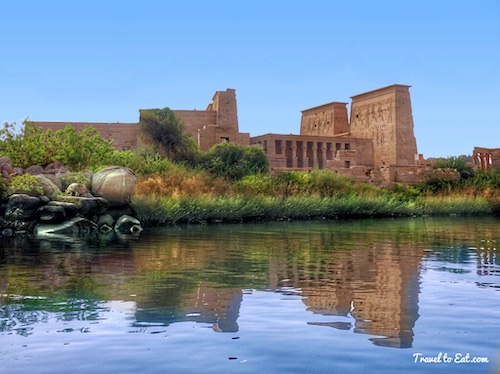
Philae, in Egyptian mythology the neighboring island of the burying-places of Osiris (island of Bigeh), was held in high reverence both by the Egyptians to the north and the Nubians to the south. Philae was dedicated preeminently to Isis, sister-wife to Osiris, and patroness of the Ptolemaic rule. Although Isis was the major deity honored on Philae, the location of the island on the frontier between Egypt and Nubia meant that cults of Nubia were also featured on the island, represented by significant cult buildings. It was deemed profane for any but priests to dwell there. Temples to Isis began in the 30th dynasty and continued through the Ptolmaic Dynasties into Roman times. Isis is a very important figure in the ancient world. She is associated with funeral rites but as the enchantress who resurrected Osiris and gave birth to Horus she is also the giver of life, a healer and protector of kings. She was known as “Mother of God” (meaning mother of the pharaoh and was represented with a throne on her head). During the Roman period her cult spread throughout Greece and the Roman Empire. There was even a temple dedicated to her in London. Partially to completely flooded by the old dam's construction in 1902, the Philae complex was dismantled and relocated to Agilkia island, as part of a wider UNESCO project related to the 1960s construction of the Aswan High Dam. The relocation of these structures was done in a manner to mimic the original island of Philae.
Bigeh Island
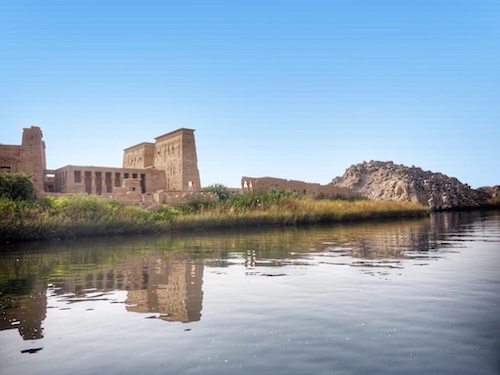
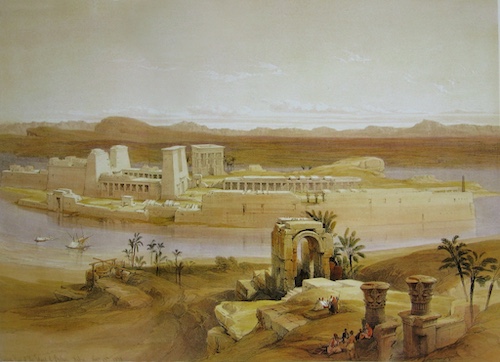
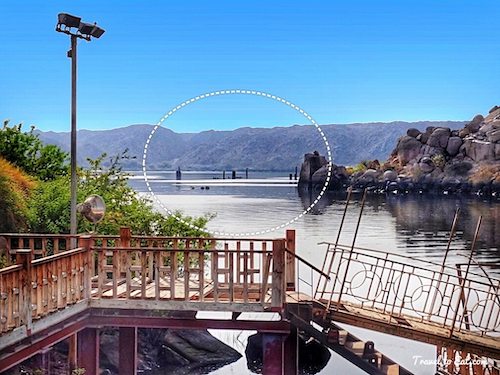
Bigeh island was sacred to the ancient Nubians and Egyptians. Bigeh (Bigge, Bigga) or for the Nubians Senmet is a larger island about a hundred meters from Philae (and Agilkia), where it is believed that one of the 16 mythical tombs of Wesir (Osiris) was situated. Thus it was natural the the nearby island of Philae would be dedicated to his wife Isis. Access to the island was generally forbidden, another name for it was “Abaton”, meaning “inaccessible”. Those who obtained permission to enter the island had to speak in whispers, if at all. The source of the Nile, manifested as the god Hapy was thought to live in a cave here, the entrance being protected by a sacred serpent. It is thought that there may have been a Temple of Thoth on the island. The orientation of the Temple of Isis to the island of Bigeh naturally changed when the temple was relocated to Agilkia island. You can actually see bits of the markers used in the relocation on the Island of Philae from the landing on Agilika island.
Processional of the Temple of Isis
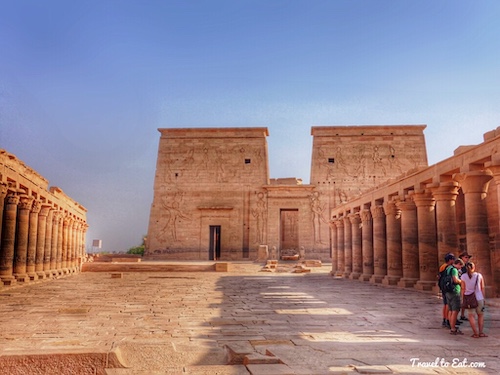
The entrance to the main temple is fronted by the first Great Pylon. It stands 150 feet broad and 60 feet high, consisting of two towers and a gate between them. There are deep grooves for flag poles cut on either side of the portal. The pylon was begun by Potlemy II Philadelphus and essentially finished by Ptolemy III Euergetes I, though the decorations were carried out over a much longer period. In fact, they were never really finished. The small door to the left leads to the mammisi or birth house. Mammisi (Mamisi) is a term used for a small chapel attached to a larger temple, and associated with the nativity of a god. The word is derived from Coptic and is attributed to Jean-François Champollion. At Philae the erection of the Mammisi of Harpocrates (Horus the Child), son of Isis and Osiris, was begun under the Ptolemies and improved upon by the Romans. The veneration of divine triads of a father, a mother, and a child deity was widespread. Divine birth myths of pharaohs are also known since the New Kingdom, and the king in his youth was often identified with the child god. The mammisi cults were part of bringing about rebirth and strengthening of the kingship. The increasing number of birth houses during the last centuries of the ancient Egyptian culture reflected the growing importance of the child deities, chief among them Harpocrates, who often shown together with his mother Isis. The child represented a new beginning and growth thanks to the loving care of his mother. The mother and child cult of Isis and Horus spread throughout the Roman Empire and was mirrored in Christianity, where the suckling Hathor and Isis became the familiar Madonna and child.


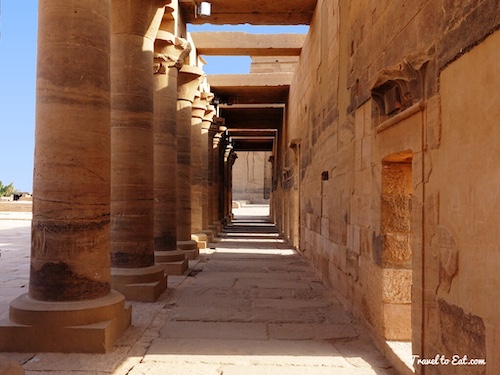
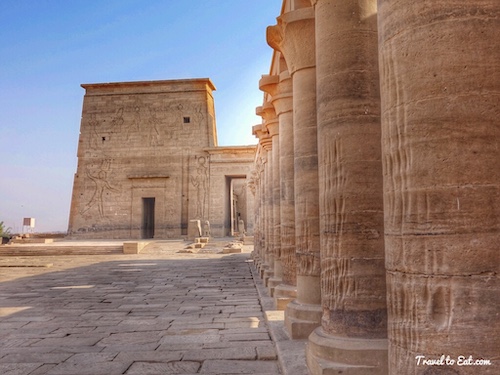
Ancient Egyptian temples were meant as places for the gods to reside on earth. Indeed, the term the Egyptians most commonly used to describe the temple building, ḥwt-nṯr, means “mansion (or enclosure) of a god”. A god's presence in the temple linked the human and divine realms and allowed humans to interact with the god through ritual. These rituals, it was believed, sustained the god and allowed it to continue to play its proper role in nature. They were therefore a key part of the maintenance of maat, the ideal order of nature and of human society in Egyptian belief. The most important part of the temple was the sanctuary, which typically contained a cult image, a statue of its god. The rooms outside the sanctuary grew larger and more elaborate over time, so that temples evolved from small shrines in the late Predynastic Period (late fourth millennium BC) to massive stone edifices in the New Kingdom (1550–1070 BC) and later, as you can see above. Their typical design consisted of a series of enclosed halls, open courts, and massive entrance pylons aligned along the path used for festival processions. The causeway or processional path leading from the landing quay eventually entered the temple proper marked by its surrounding enclosure wall, called sebty during Egypt's New Kingdom, when they were most common.
Temple Built by King Nectanebo II

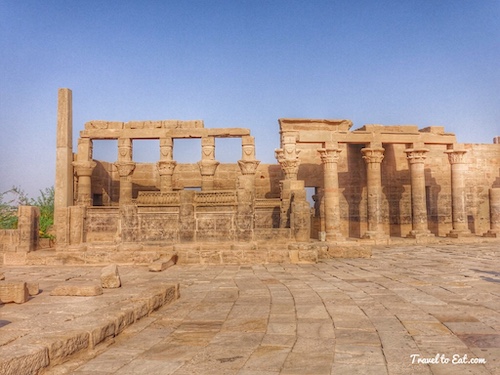
The earliest architectural temple on Philae is that of King Nectanebo II (350-341 BC) of the 30th Dynasty. It was dedicated to Hathor, Isis, and the gods of Senmet (Island of Bigeh) sacred to the Nubians. At this time, there was the belief that Philae was the island of burial of one of the members of the mutilated body of Osiris. The island became the scene of one of the Osiris passion-plays, similar to those held at Abydos and elsewhere. The great shrine of Osiris at Abydos had by this time fallen into decay and its reputation transferred to Philae. This brought crowds of worshipers to the island. The temple was restored by Ptolemy II, Philadelphus (B.C 283-245). It was originally supported by fourteen columns but only six survive. These have floral capitals and sistrum capitals bearing Hathor head. The columns were united by stone screens six feet high having reliefs showing Nectanebo sacrificing to the gods. These columns are crowned with cavetto cornices and rows of uraei serpents (see my post on Philae architectural elements).
Maps of Philae and Re-Creation at Agilkia
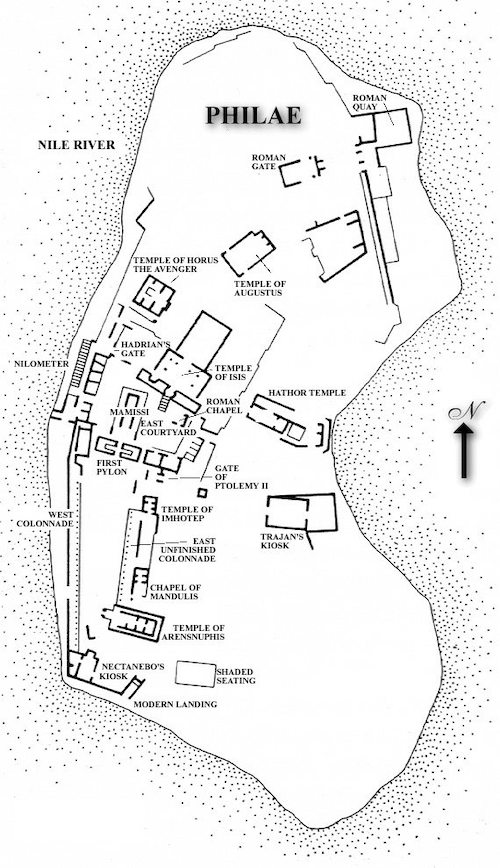
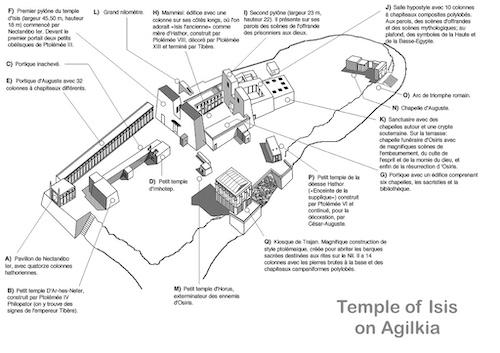
Entrance to the Temple of Isis
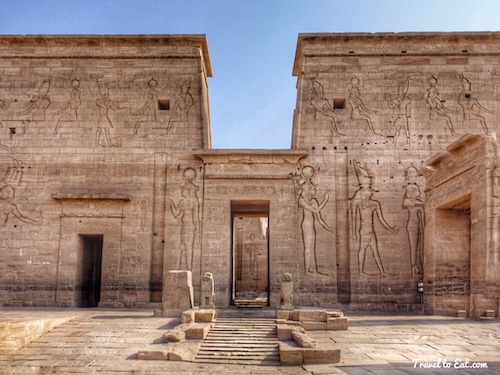

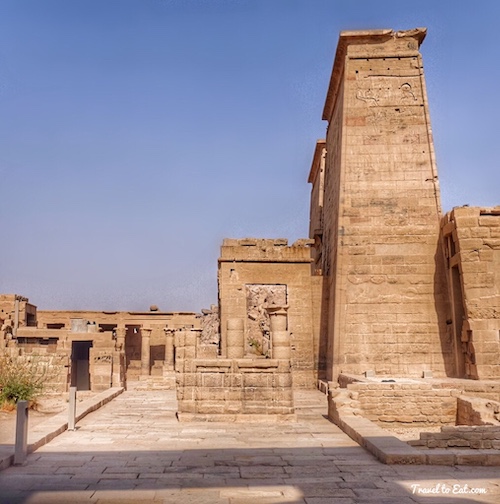

Just before the main gateway to the first pylon are two Roman style lions carved from pink granite that have been re-erected on this island from their fallen position on the old Island of Philae. Two obelisks once also stood here, erected by Ptolemy VIII Euergetes II and his second wife, Cleopatra III (who is not the more famous Cleopatra VII). These obelisks made of pink granite are not lost to us, but may now be found at Kingston Lacy in Dorset in the UK. The eastern obelisk, which measures 6.7 meters (22 feet) tall and weighs six tons, was found on its side half-buried and its western counterpart was badly damaged and only about a third of it remained. They were taken by Mr. Ralph Bankes for his garden. Interestingly, they were partly instrumental in the decipherment of hieroglyphics (see my post on the Rosetta Stone).
Forecourt of the Temple of Isis

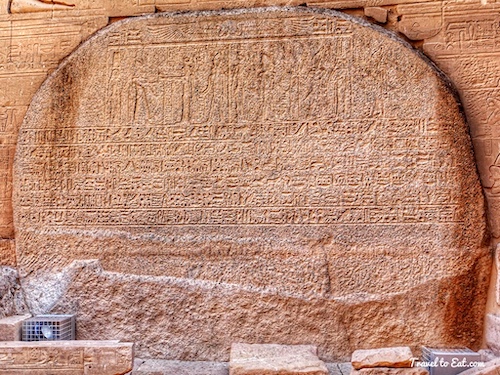
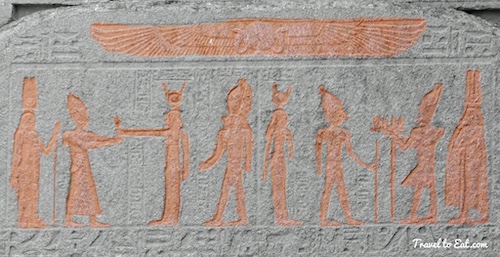
At the base of the eastern inner tower, part of the granite foundation of the original island protruded and this was carved into a stele on which Ptolemy VI Philometor, and his queen Cleopatra II stand before Isis and Horus under a scarab with the wings of Isis. This stele was faithfully transferred to the new island with the rest of the temple. An inscription refers to the grant of the Dodekaschoinoi made to Isis, which brought the priests of Philae into parity with those of Elephantine. Dodekaschoinoi is a Greek word for “twelve schoinoi” A schoinos equaled about seven miles. It is not a measurement of area, but rather length, so presumably this meant that their foundation estate to finance the temple extended for about seven miles along the Nile River, including the arable land. Thus the temple was given land to grow crops to feed the priests, a common practice in Egypt.
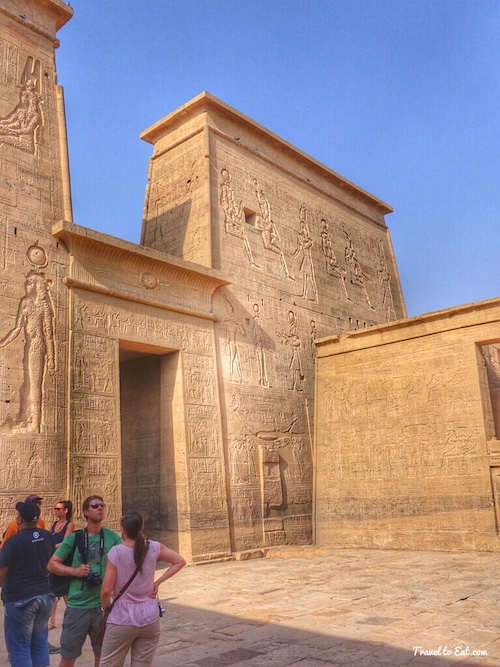
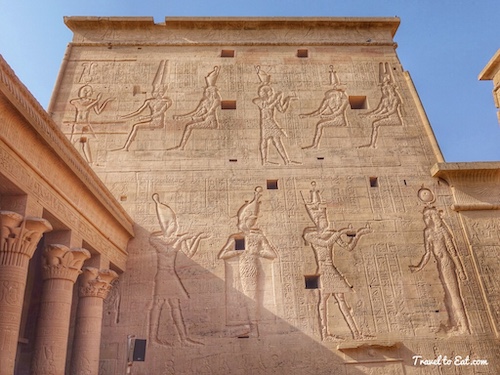
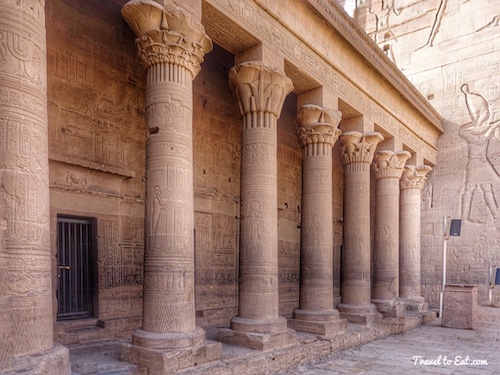
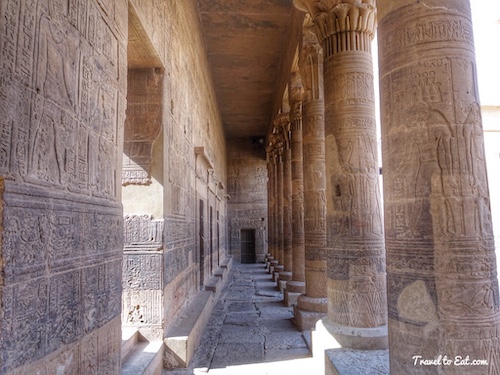
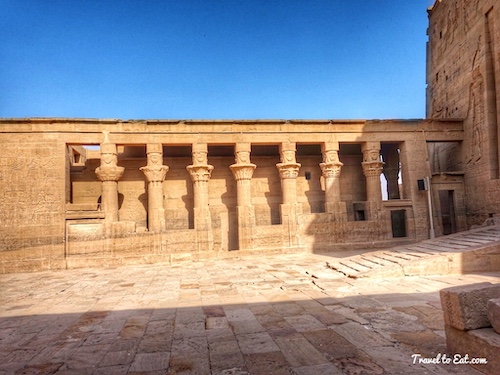
The building work in the Temple of Isis proper at Philae, now located on the island of Agilika, is overwhelmingly Ptolemaic and forms part of the Ptolemaic policy of promoting the Isis cult throughout the kingdom and beyond. The core of the Isis temple, everything north of the forecourt, was built by Ptolemy II. The temple was primarily dedicated to Isis, who was worshipped here with her son, Horus, and Harpocrates. The Greek Harpocrates (God of silence) was derived by the Greeks from the Egyptian god Harpa-Khruti (Horus the Child) who was portrayed as a small boy with a finger held to his lips–an Egyptian gesture, symbolising childhood, which the Greeks mistook for a hush of silence. Osiris's name is generally written within a cartouche, with the words indicating “Deceased” (since he was God of the Underworld), and Isis's name was also written within a cartouche. In this region they were seen as deified rulers. The principal deity of the temple complex was Isis, but other temples and shrines were dedicated to others such as Hathor and Horus.
Hypostyle Hall at the Temple of Isis

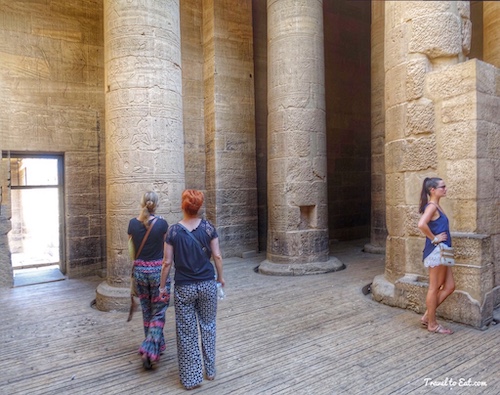
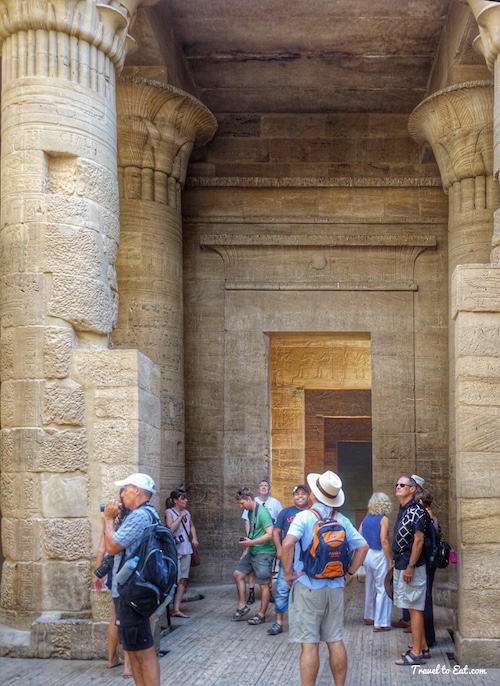
The Hypostyle Hall consists of ten huge pillars. Once beautifully painted, the pillars symbolize the first plants, trees, and flowers of the earth which began to grow on the Primeval Mound (symbolized by the temple floor). On the ceiling (representing the sky), are images of the Day Boat and the Night Boat, and of the vultures of Upper and Lower Egypt. The Temple of Isis was closed down officially in the 6th century AD by the Byzantine emperor, Justinian (527-565 AD), one of the last temples to be closed. Philae was a seat of the Christian religion as well as of the ancient Egyptian faith before and after that time as you can see from the crosses on the columns in the hypostyle. The remainder of the temple or sanctuary is a maze of small passages covered with hieroglyphs and reliefs of gods/goddesses which I will cover in a separate post.
Other Structures on Agilkia Island
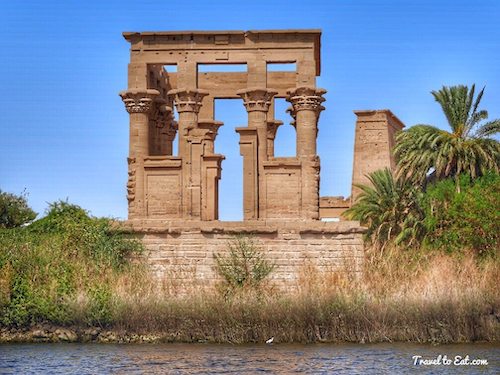

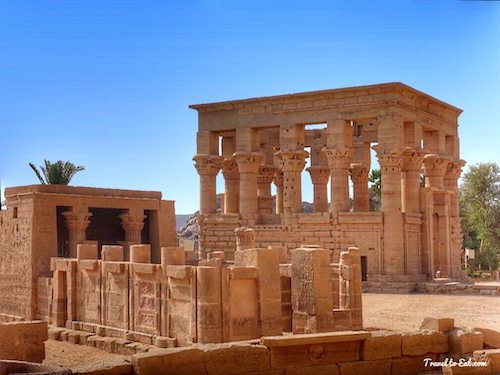
Known to the locals as “Pharaoh's Bed,” the Kiosk of Trajan originally served as the main entrance into the temple from the river. It originally had a wooden roof which has not been restored. Inside, the Roman emperor Trajan is depicted making offerings to the Egyptian gods. The Kiosk is often credited to Trajan, but it might well have been built earlier than this, possibly during the reign of Augustus. This unfinished building is one of the most popular monuments of Philae and was in ancient times the formal entrance to the island.
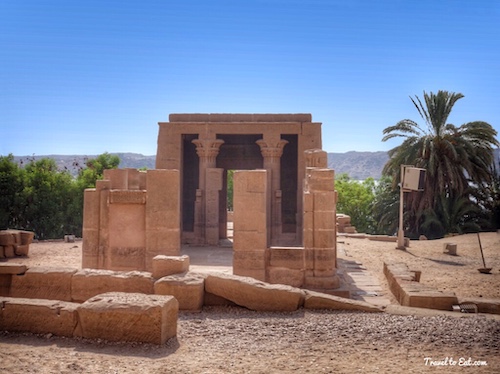
The Temple of Hathor was built by Ptolemy VI Philometor and Ptolemy VIII Euergetes II. It consists of a colonnaded hall and a forecourt. The colonnade was decorated by Augustus and is filled with carvings of festivities in recognition of Isis and Hathor.
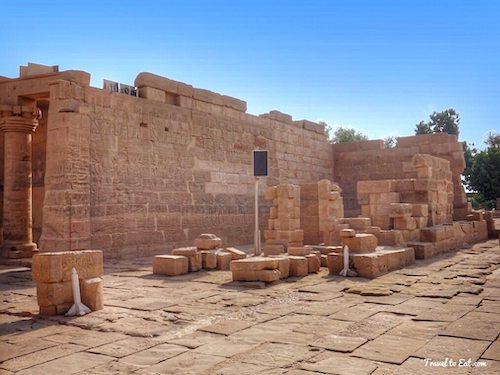
Arensnuphis apparently began to be worshipped in Upper Egypt in the third and second century BCE, after he had had a cult in Nubia for two to three hundred years. In a joint venture with the Meroitic king Arqamani, Ptolemy IV erected an Arensnuphis sanctuary on the island of Philae at the beginning of the east colonnade in the processional area. Arensnuphis was worshipped at Philae, where he was called the “companion” of the Egyptian goddess Isis, as well as at Dendur. Not much is really known about him.
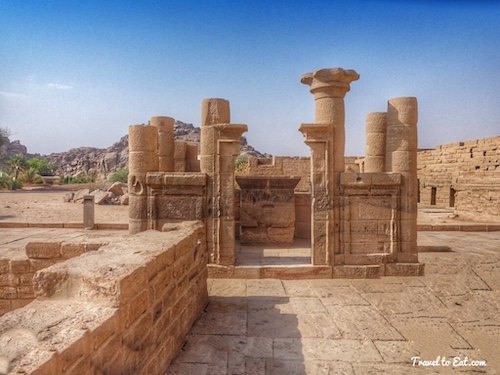
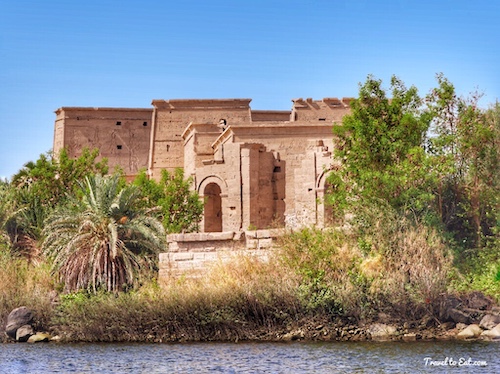
As with all ruins, it takes a bit of imagination to imagine the temple as it was, even though this is one of the best preserved temples. Nonetheless it was a busy religious place by all accounts and based on the number of temples which effectively filled the island of Philae. I have two additional posts on Philae, one on decorative elements and one on the wall carvings in the sanctuary.
[mappress mapid=”127″]
References:
Tour Egypt has an exceptional five part series on the Temple of Isis that is the most authoritative description I have found and is almost required reading if you plan to visit. You can find it here: http://m.touregypt.net/featurestories/philae.htm
Bigeh: https://web.archive.org/web/20120419073619/http://www.philae.nu/akhet/Philaebigeh.html
Map of Phylae: http://m.touregypt.net/Map20.htm
Discovering Ancient Egypt: http://discoveringegypt.com
Egyptian Gods: http://www.nemo.nu/ibisportal/0egyptintro/1egypt/
Hathor: http://www.joanannlansberry.com/other/hathor/hathor.html
Symbols and Definitions: http://www.egyptartsite.com/symlst.html

